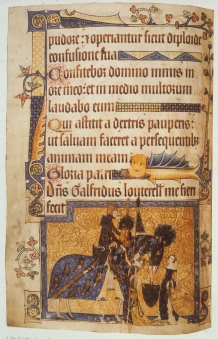Period Band: A
Curatorial Rating: unrated
Seeing and Being Seen: English Art in the 14th Century
Tutor: Tim Ayers
Description
This course explores the importance of the visual in a century that saw great changes in English society, economy and politics; including the Black Death, the Hundred Years War and, ultimately, the replacement of the ruling Plantagenet dynasty. How may these be related to changes in representation?
Taking advantage of a rich literature on medieval bodies, visualities and identities, the course will range in scope from academic theories of vision, to wider understandings of the importance of sight and the senses, and medieval aesthetics. Themes include the development of portraiture, and the role of the visual in the fulfilment of spiritual needs, both public and personal. At court and on the battlefield, colourful display was a central part of royal and aristocratic life in this ‘age of chivalry’, in a culture that spanned the channel. The period witnessed the production of such individual wonders as the Luttrell Psalter and the Wilton Diptych, but also the development of architectural spaces, such as Ely cathedral and York Minster, in which art was part of ritual and performance.
Objectives
By the end of the module students should have acquired:
- A familiarity with a wide range of artworks and buildings produced in England during the 14th century.
- An understanding of current critical debates about medieval visuality and aesthetics.
- The ability to analyse art and architecture in contexts both secular and ecclesiastical, and to think about relationships between them.
Preliminary Reading
- Age of Chivalry, Art in Plantagenet England, 1200–1400, exh. cat., Royal Academy of Arts, London, 1987
- P. Binski, Westminster Abbey and the Plantagenets, Kingship and the Representation of Power, 1200–1400, New Haven (CT)/London, 1995
- P. Binski, Gothic Wonder, Art, Artifice and the Decorated Style, 1290-1350, New Haven/London, 2014
- C. M. Carruthers, The Experience of Beauty in the Middle Ages, , Oxford, 2013
- J. Hamburger and A.-M. Bouché (eds.), The Mind’s Eye: Art and Theological Argument in the Middle Ages, Princeton, 2006
- C. M. Woolgar, The Senses in Late Medieval England, New Haven/London, 2006

Module code HOA00062I
